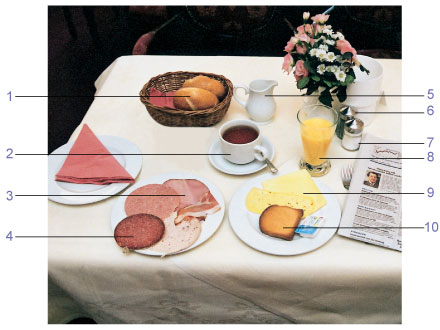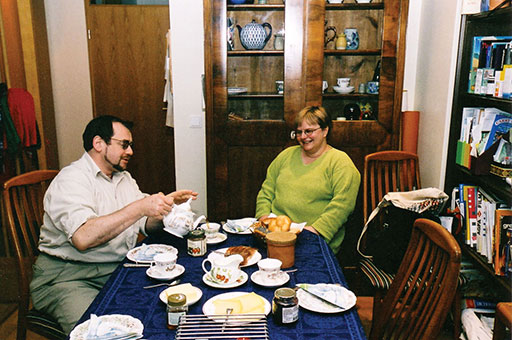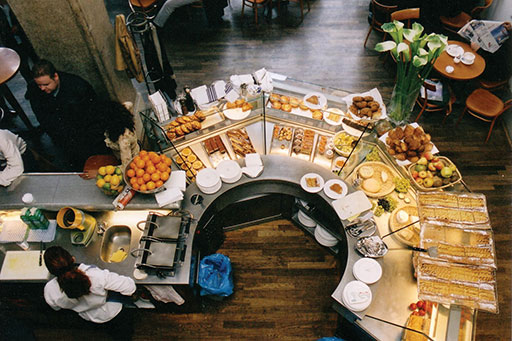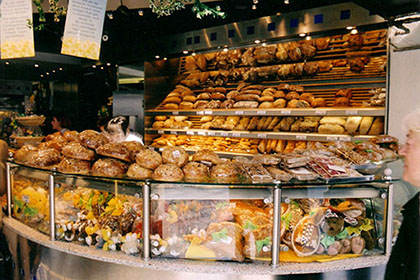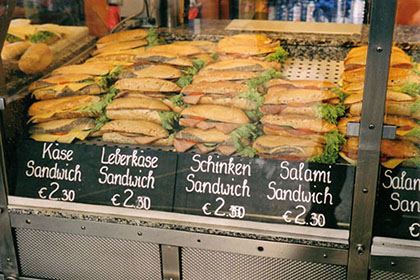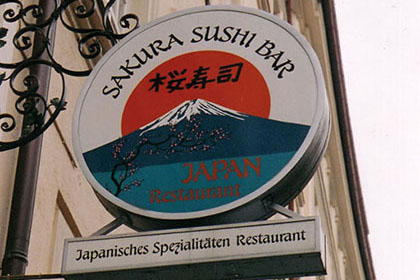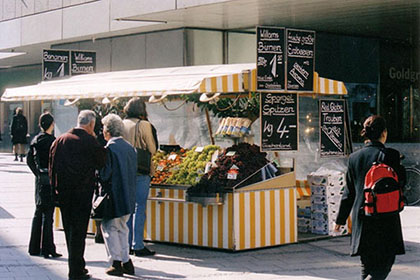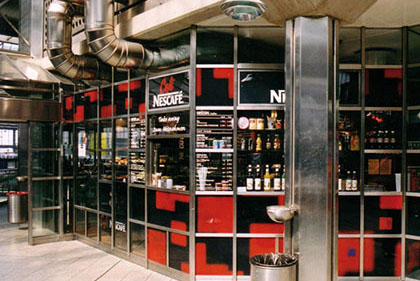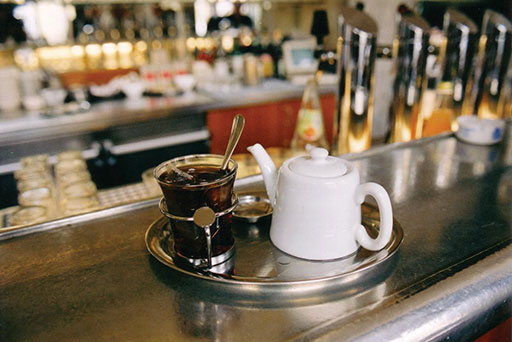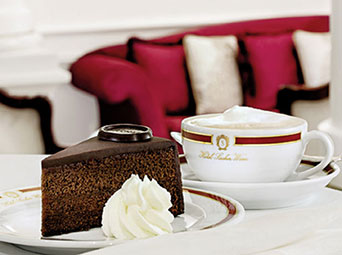Beginners' German: Food and drink
Use 'Print preview' to check the number of pages and printer settings.
Print functionality varies between browsers.
Printable page generated Friday, 19 April 2024, 5:27 PM
Beginners' German: Food and drink
Introduction
This course focuses on expressing your own food and drink preferences, and explores meal times and eating habits in German-speaking countries. You will read and hear about a range of types of food and drink.
You will also find out how to order and pay for things in cafes and restaurants.
Most importantly, you will find out what it’s like to read and listen to German in real contexts, and about developing strategies and studying useful phrases, which will help you to cope in a range of situations.
This OpenLearn course is an adapted extract from the Open University course L193 Rundblick: beginners' German.
Learning outcomes
After studying this course, you should be able to:
speak about personal preferences with regard to food and drink
order and pay for food and drink in a restaurant
use the verbs essen and trinken
demonstrate an awareness of different types of snacks, different meal times and different places to eat in German-speaking countries
recognise the distinct pronunciation of German native speakers from Austria.
1 Breakfast foods
Activity 1
This is a picture of a breakfast table with typical German breakfast foods. Look at the image and then match the label numbers to the correct food names.
das Brötchen
1
der Kaffee
2
der Schinken
3
die Wurst
4
die Milch
5
der Pfeffer
6
das Salz
7
der Orangensaft
8
der Käse
9
der Toast
10
Using the following two lists, match each numbered item with the correct letter.
das Brötchen
der Kaffee
der Schinken
die Wurst
die Milch
der Pfeffer
das Salz
der Orangensaft
der Käse
der Toast
a.9
b.1
c.2
d.7
e.6
f.8
g.4
h.10
i.5
j.3
- 1 = b
- 2 = c
- 3 = j
- 4 = g
- 5 = i
- 6 = e
- 7 = d
- 8 = f
- 9 = a
- 10 = h
Skills: Memorising nouns with pictures
A useful strategy for memorising nouns is to learn the words in connection with pictures until you can cover the words and name each of the items with its correct article using just the picture.
Language: Using der, die, das and ein, eine
In the first activity you came across some of the German articles der, die, das (the). Here is how they work:
These articles identify the grammatical gender of a noun. All German nouns have a grammatical gender. They are either masculine, feminine or neuter. Sometimes the gender is predictable, for example the word for man, Mann, is masculine and the word for woman, Frau, is feminine. But this is not true for a lot of nouns. They just happen to be either masculine or feminine or neuter. The article for each gender is different. The German for ‘the’ can be either der, die or das depending on the gender of the noun. Similarly, the German for ‘a/an’ can be ein or eine depending on the gender.
| ‘the’ | ‘a’ | |||
| masculine (m.) nouns | der | der Kaffee | ein | ein Kaffee |
| feminine (f.) nouns | die | die Wurst | eine | eine Wurst |
| neuter (nt.) nouns | das | das Brötchen | ein | ein Brötchen |
| all nouns in the plural | die | die Eier | – | – |
You can also see that all German nouns begin with a capital letter. Note that you may come across articles other than the ones above.
Activity 2
Now listen to three people talking about what they usually eat (essen) and drink (trinken) for breakfast (Frühstück). Don’t reach for the dictionary yet – see how much you can understand first. Note down the breakfast items you hear each person mention.
Transcript: Audio 1
Hören Sie bitte.
Mann 1:
Mann 2:
Frau:
Answer
This table demonstrates who mentioned which items:
| Mann 1 | Mann 2 | Frau | |
| Kaffee | ✘ | ✘ | |
| Milch | ✘ | ||
| Müsli | ✘ | ✘ | |
| Ei | ✘ | ||
| Toast | ✘ | ✘ | ✘ |
| Brot | ✘ | ✘ | |
| Brötchen | ✘ | ✘ | |
| Schinken | ✘ | ||
| Käse | ✘ | ✘ | ✘ |
| Marmelade | ✘ | ✘ | ✘ |
| Jogurt | ✘ |
Culture: Traditional German breakfast foods
Did you notice that none of the interviewees in the audio clip mentioned a cup of tea? Although the couple pictured here are drinking tea, coffee is much more popular at breakfast time. Slices of cold meat or slicing sausage (Aufschnitt, Wurst), ham (Schinken) and cheese (Käse) are also very common breakfast foods, as well as hard-boiled eggs (gekochte Eier) and Marmelade, which is not just marmalade (Orangenmarmelade) but any kind of jam.
Language: Personal pronouns
Here is a list of German pronouns.
| singular | plural | singular and plural | |||
|---|---|---|---|---|---|
| ich | I | wir | we | Sie | you (when talking to one or more adults who are not very close friends or relatives of yours) |
| du | you (when talking to a close friend, a relative or a child) | ihr | you (when talking to two or more close friends, relatives or children) | ||
| er | he | sie | they | ||
| sie | she | ||||
| es | it | ||||
Note that sie with a small ‘s’ means ‘she’ and also ‘they’. Sie with a capital ‘S’ means ‘you’. There are several ways of saying ‘you’ in German (du, ihr and Sie) but Sie is the most useful for talking to German-speaking people when you meet them.
Language: The verbs essen and trinken
Here is the present tense of the irregular verb essen (to eat) and the regular verb trinken (to drink). You will see that the ending of the verb changes depending on whether it follows ich, du etc. Only the second and third person singular (du and er/sie/es) forms of essen are irregular, with a change in the vowel sound.
| essen | trinken |
|---|---|
| ich esse | ich trinke |
| du isst / Sie essen | du trinkst / Sie trinken |
| er/sie/es isst | er/sie/es trinkt |
| wir essen | wir trinken |
| ihr esst / Sie essen | ihr trinkt / Sie trinken |
| sie essen | sie trinken |
- Vokabeln (vocabulary)
- Cornflakes (pl.) cornflakes
Activity 3
Listen to the clip below, with five recorded questions about what various people have for breakfast. In the gap after the questions, answer according to the picture prompts below, replacing the person’s name each time with the appropriate personal pronoun. You may want to use the transcript to help you.
Beispiel (example)
You hear: Was isst Sara zum Frühstück?
You say: Sie isst Brötchen.
You hear: Sie isst Brötchen.
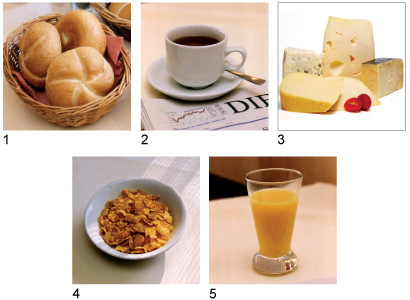
These are photos of the following food items: 1: three bread rolls; 2: a cup of coffee; 3: different cheeses; 4: a bowl of cereal; 5: a glass of orange juice
Transcript: Audio 2
Bitte hören Sie und sprechen Sie.
2 Ordering breakfast
Activity 4
Here is a chance to practise the forms of essen you learned in the previous section. Write down the missing forms of the verbs to complete the sentences. Try it from memory first – but you can check back if you need.
- 1. Was _________ Sie zum Frühstück?
- 2. Ich _________ Brötchen mit Schinken.
- 3. Was _________ du zum Frühstück?
- 4. Ich _________ Müsli und Jogurt.
- 5. Was _________ ihr zum Frühstück?
- 6. Wir _________ Brot mit Butter und Käse.
- 7. Und was _________ Andreas?
- 8. Er _________ Toast mit Marmelade.
Answer
- Was essen Sie zum Frühstück?
- Ich esse Brötchen mit Schinken.
- Was isst du zum Frühstück?
- Ich esse Müsli und Jogurt.
- Was esst ihr zum Frühstück?
- Wir essen Brot mit Butter und Käse.
- Und was isst Andreas?
- Er isst Toast mit Marmelade.
- Vokabeln
- Sorten (f. pl.) kinds, sorts
Activity 5
It’s breakfast time at a hotel in Munich. Listen to the recording, then list the following items in the order in which the restaurant supervisor, Frau Vogt, mentions them. You don’t need to understand everything she says. Just focus on the items listed below.
Transcript: Audio 3
Hören Sie bitte.
Brot
1
Obst
2
Käse
3
Wurst
4
Jogurt
5
Marmeladen
6
Kaffee
7
Vollkornbrötchen
8
Using the following two lists, match each numbered item with the correct letter.
Brot
Obst
Käse
Wurst
Jogurt
Marmeladen
Kaffee
Vollkornbrötchen
a.2
b.8
c.3
d.7
e.4
f.5
g.1
h.6
- 1 = g
- 2 = a
- 3 = c
- 4 = e
- 5 = f
- 6 = h
- 7 = d
- 8 = b
Answer
Note: One of the words, Marmeladen (jams), is a plural.
Culture: German bread
You may have heard Frau Vogt say that she liked to eat Vollkornbrötchen (wholemeal rolls). She also said, ‘ Bei uns gibt es verschiedene Brotsorten.’ Over 300 different varieties of bread are produced in Germany, with many regional specialities. These include various types of Schwarzbrot (wholegrain rye bread), crusty bread from the Black Forest (Schwarzwälder Krustenbrot), dark rye bread from Westphalia (Westfälischer Pumpernickel), and many varieties of bread roll (Brötchen), which are known as Schrippen in and around Berlin, Semmeln or Weckerl in southern Germany and Austria, and Rundstücke in northern Germany.
Activity 6
Now see how much of the new vocabulary you remember. In the audio clip below, you’ll hear two hotel guests being asked what they are having for breakfast. Notice the use of the verb frühstücken (to have breakfast). Then list the pictures (a)–(d) beneath the audio clip, in the order in which they are mentioned.
Transcript: Audio 4
Bitte hören Sie.
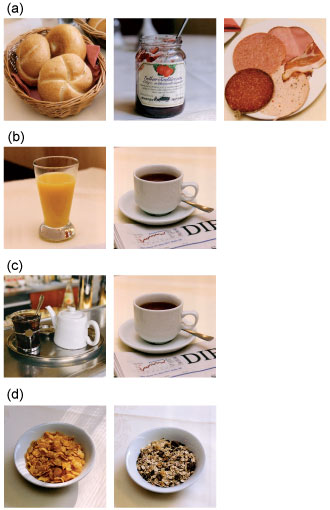
Picture (a)
1
Picture (c)
2
Picture (d)
3
Picture (b)
4
Using the following two lists, match each numbered item with the correct letter.
Picture (a)
Picture (c)
Picture (d)
Picture (b)
a.2
b.3
c.4
d.1
- 1 = d
- 2 = a
- 3 = b
- 4 = c
Answer
- (a) Brötchen, Marmelade, verschiedene Wurstsorten
- (c) Tee, Kaffee
- (d) Cornflakes, Müsli
- (b) Orangensaft, Kaffee
Skills: Learning vocabulary by saying it out loud
You might like to try the following strategy for learning new words and phrases:
- Look at the word or phrase.
- Check its pronunciation using recordings, if available.
- Speak it out loud.
- Cover the text.
- Speak it out loud again.
- Write it down from memory.
- Check your spelling.
If you want a really challenging word to learn, try Frühstücksbüffet!
Activity 7
Here you review the expressions you have come across so far. You are playing the part of a member of the hotel staff. Listen to the questions and answers, and practise saying the answers yourself. You may want to use the transcript to help you.
Transcript: Audio 5
Bitte hören Sie und sprechen Sie.
Was frühstücken die meisten Gäste?
➜
Sie essen Brötchen und verschiedene Sorten Wurst oder Marmelade.
Und was gibt es zum Trinken?
➜
Es gibt Orangensaft und Kaffee.
Und Sie? Was trinken Sie?
➜
Ich trinke Tee oder Kaffee.
Was essen Sie meistens?
➜
Ich esse Cornflakes oder Müsli.
How would you have answered the last two questions? Practise giving your own answers out loud.
3 Likes and dislikes
Language: Expressing likes and dislikes
If you want to say what you like to do in German, you just add gern after the verb (you may also hear people say gerne), and the verb (esse, trinke) stays the same. Think of gern as meaning ‘with pleasure’.
| Florian isst Fleisch. | Florian eats meat. |
| Florian isst gern Fleisch. | Florian likes to eat meat. (lit. ‘Florian eats with pleasure meat.’) |
| Anna trinkt Kakao. | Anna drinks cocoa. |
| Anna trinkt gern Kakao. | Anna likes to drink cocoa. |
To say you like it very much, add sehr gern; to say you don’t like something, add nicht gern.
| Ich trinke sehr gern Wein. | I like (to drink) wine very much. |
| Er isst nicht gern Gemüse. | He doesn’t like (to eat) vegetables. |
Activity 8
In this activity you will practise talking about the food and drink you like or dislike.
There are four audio questions below. Each clip is followed by a text prompt to use in your answer. Use these prompts to answer aloud in a full sentence, before playing the model answer. You may want to use the transcript to help you. If you like, you can repeat the exercise, giving your own personal answers instead of the ones suggested.
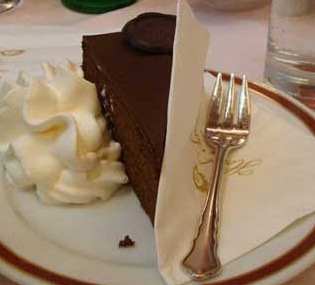
Question 1:
Prompt: Sachertorte
Model answer:
Question 2:
Prompt: Käse
Model answer:
Question 3:
Prompt: Kaffee
Model answer:
Question 4:
Prompt: Tee mit Zitrone
Model answer:
Skills: Recording yourself
To practise and improve your German fluency and pronunciation you can try recording yourself and comparing your way of speaking with that of the speakers you hear in these materials. There are a number of free online recording tools available – you may have recording software on your computer, or you could use a mobile phone. The best approach to this kind of practice is that you do the speaking activities in these materials and record your responses. Then listen again to your response and re-record until you are happy with it. Finally, listen again to the recording in the activity and compare it with your own recording.
Activity 9
Listen to Herr Schuster and Frau Georg talking about what they like to eat and drink. Make some notes about what they each like/dislike, and how much they like/dislike it. You can check the transcript for any wording.
Transcript: Audio 6
Hören Sie bitte.
Herr Schuster: Ja, ich trinke gern Apfelsaft. Ich esse sehr gern Käse. Müsli esse ich überhaupt nicht gern!
Frau Georg: Nein, ich trinke nicht gern Kaffee. Ich koche besonders gern griechisch. Ich arbeite gar nicht gern im Restaurant.
Answer
| überhaupt nicht gern | gar nicht gern | nicht gern | gern | sehr gern | besonders gern | |
|---|---|---|---|---|---|---|
| Herr Schuster | Müsli essen | Apfelsaft trinken | Käse essen | |||
| Frau Georg | im Restaurant arbeiten | Kaffee trinken | griechisch kochen |
- Vokabeln
- das Gemüse vegetables
Activity 10
Practise what you have learned about expressing likes and dislikes by writing sentences to say what you and other people like or don’t like, using the cues below. Then write a few more sentences about your own personal preferences.
Beispiel
(Thomas/essen) Gemüse
; Obst
; Pfirsiche

Thomas isst nicht gern Gemüse.
Er isst sehr gern Obst.
Er isst besonders gern Pfirsiche.
- 1. (Frau Meyer/trinken) Saft
 ; Wein
; Wein  ; Rotwein
; Rotwein 


- 2. (ich/kochen) italienisch
 ; mexikanisch
; mexikanisch 
 ; chinesisch
; chinesisch 
- 3. (wir/essen) Weißbrot

 ; Krustenbrot
; Krustenbrot  ; Vollkornbrot
; Vollkornbrot 
- 4. Und Sie … ? Was essen Sie gern? Was trinken Sie gern? Was kochen Sie gern?
Answer
- Frau Meyer trinkt sehr gern Saft. Sie trinkt gern Wein. Sie trinkt überhaupt nicht gern Rotwein.
- Ich koche gern italienisch. Ich koche besonders gern mexikanisch. Ich koche nicht so gern chinesisch.
- Wir essen nicht gern Weißbrot. Wir essen gern Krustenbrot. Wir essen sehr gern Vollkornbrot.
- Make sure your own sentences have the right verb forms: ich esse, ich trinke, ich koche.
Comment
Notice the letter ß in Weißbrot. This is pronounced like s and is used instead of double- s after long vowel sounds in words like Weißbrot (white bread) and Straße (street).
Activity 11
You have come across quite a few words containing ch in the previous activities, such as Milch and Brötchen. This ch should sound like the ‘h’ in ‘human’. Practise your pronunciation as you listen and repeat what you hear in the recording. You may find it useful to record yourself in order to check that you are distinguishing the German ch from the English sounds ‘sh’ and ‘ck’.
Transcript: Audio 7
Hören Sie und sprechen Sie nach.
ich – mich – dich ➜
Ich trinke Milch. ➜
Trinkst du Milch? ➜
Ja, Milch für mich. ➜
Und für dich? ➜
Ich trinke nichts. ➜
Nimmst du ein Brötchen? ➜
Natürlich! ➜
Isst du gern griechisch? ➜
Nein, überhaupt nicht. ➜
Aber ich esse sehr gern chinesisch. ➜
4 Where to eat
Culture: Meals and snacks in German-speaking countries
The three main meals (Hauptmahlzeiten) are das Frühstück, das Mittagessen and das Abendessen. Although some working patterns make it more convenient to have a hot meal in the evening, traditionally the main cooked meal in Germany, Austria and Switzerland is taken at lunchtime, with the evening meal often consisting of bread with a selection of cheeses, cold cooked meats and salads, hence the alternative name of das Abendbrot.
There are many different regional names for snack times between meals (Zwischenmahlzeiten). These include die Brotzeit in Bavaria, die Jause in Austria and das z’Nüni in Switzerland.
In many parts of Germany there is a tradition known as der Frühschoppen, where locals get together in a bar or inn (das Wirtshaus) after church on a Sunday morning for a chat over a glass of beer or wine. As regular customers, they will often have a table (der Stammtisch) which is always reserved for them.
Activity 12
You can buy food and drink in many different places. Match photos 1–6 to the descriptions beneath.
Photo 3
Hier kann man japanisch essen.
Photo 6
Hier kann man Kaffee trinken.
Photo 4
Hier kann man Bratwurst kaufen.
Photo 2
Hier kann man ein Schinkenbrötchen kaufen.
Photo 5
Hier kann man Obst und Gemüse kaufen.
Photo 1
Hier kann man Brot kaufen.
Using the following two lists, match each numbered item with the correct letter.
Photo 3
Photo 6
Photo 4
Photo 2
Photo 5
Photo 1
a.Hier kann man Brot kaufen.
b.Hier kann man Bratwurst kaufen.
c.Hier kann man japanisch essen.
d.Hier kann man Kaffee trinken.
e.Hier kann man Obst und Gemüse kaufen.
f.Hier kann man ein Schinkenbrötchen kaufen.
- 1 = c
- 2 = d
- 3 = b
- 4 = f
- 5 = e
- 6 = a
Language: Making generalisations using man
Man is often translated into English as ‘one’. When you are talking about people in general in English, you might say ‘you’, ‘they’ or ‘people’ rather than the formal-sounding ‘one’, but man doesn’t have the same formal ring to it in German. Compare the following sentences, for example:
Was isst man hier? | What do people eat here? / What do they eat here? |
To talk about what is on offer at certain places, you can combine man with kann:
Was kann man hier trinken? | What can you drink here? (lit. ‘What can one drink here?’) |
The verb used with man takes the same verb form as with er/sie/es (e.g. man isst, man kann).
Activity 13
a.
die Bar (-s)
b.
das Café (-s)
c.
das Gasthaus (die Gasthäuser)
d.
der Gasthof (die Gasthöfe)
e.
die Gaststätte (-n)
f.
das Hotel (-s)
g.
die Imbissstube (-n)
h.
die Kneipe (-n)
i.
das Lokal (-e)
j.
das Restaurant (-s)
The correct answers are a, b, c, f, i and j.

Transcript: Video 1
Activity 14
a.
chinesisch
b.
deutsch
c.
französisch
d.
griechisch
e.
indisch
f.
italienisch
g.
österreichisch
h.
spanisch
i.
thailändisch
The correct answers are a, d, e, f and i.

Transcript: Video 1 (repeated)
Language: Saying what you would like
You may be asked Möchten Sie …? (Would you like …?) to establish what you would like. To respond, use the verb form ich möchte (I would like) or wir möchten (we would like).
Möchten Sie etwas zu essen bestellen? Would you like to order something to eat?
As you listen to these expressions in the recordings, pay particular attention to the ö and ch sounds and try to copy them.
- Vokabeln
- bestellt etwas zu essen orders something to eat
Activity 15
Read the introduction to the recording below and then listen to the conversation between Thomas and a waitress. Then match the German and English phrases underneath – if you don't know all the words, try to work out the meanings from the context.
Thomas und Heike sitzen im Café. Thomas bestellt etwas zu essen und zu trinken.
Transcript: Audio 11
Hören Sie bitte.
Excuse me!
Entschuldigung!
we’d like
wir möchten
a pot of coffee
ein Kännchen Kaffee
a glass of tea
ein Glas Tee
with lemon
mit Zitrone
with cream
mit Sahne
Anything else?
Sonst noch etwas?
two pieces of apple cake
zwei Stück Apfelkuchen
Using the following two lists, match each numbered item with the correct letter.
Excuse me!
we’d like
a pot of coffee
a glass of tea
with lemon
with cream
Anything else?
two pieces of apple cake
a.mit Sahne
b.ein Kännchen Kaffee
c.ein Glas Tee
d.Sonst noch etwas?
e.wir möchten
f.Entschuldigung!
g.mit Zitrone
h.zwei Stück Apfelkuchen
- 1 = f
- 2 = e
- 3 = b
- 4 = c
- 5 = g
- 6 = a
- 7 = d
- 8 = h
Culture: Kaffee und Kuchen
Having coffee and cakes (Kaffee und Kuchen) with friends in a café or at home is a very popular way to take a late afternoon break in German-speaking countries. Some cafés specialise in what could be called the fourth meal of the day, serving coffee and a range of delicious cakes, such as cheesecake (Käsekuchen) or Austrian chocolate cake (Sachertorte). When visiting friends in the afternoon you may be offered a cup of coffee (eine Tasse Kaffee) and a piece of cake (ein Stück Kuchen). Notice that in these expressions there is no German equivalent for the English ‘of’.
5 Placing an order
Activity 16
When visiting friends or colleagues in Germany, you will normally be offered something to drink. In this audio clip, you will hear people offering a number of things to drink. Practice your responses out loud. It is up to you to choose whether to accept (ja, bitte) or decline (nein, danke) based on your preferences, so there are no right or wrong answers to this activity.
Beispiel
You hear: Möchten Sie eine Tasse Kaffee?
You say: Ja, bitte. / Nein, danke.
Transcript: Audio 12
Hören Sie und sprechen Sie.
Möchten Sie eine Tasse Kaffee?
➜
Möchten Sie einen Tee mit Zitrone?
➜
Möchten Sie einen Orangensaft?
➜
Möchten Sie ein Glas Bier?
➜
Möchten Sie eine Cola?
➜
Möchten Sie ein Glas Milch?
➜
Möchten Sie einen Schnaps?
➜
Language: Speaking politely
When you are offered something you tend to say more than just ja and nein, for example ‘yes, please’ (ja, bitte) or ‘no, thank you’ (nein, danke). Danke on its own in this context is usually understood to mean nein, danke.
In the audio clip in Activity 15 you may have noticed that the waitress used bitte schön in two different ways. First she used the phrase as a question: Bitte schön? meaning ‘Yes, please?’ to ask what the customers wanted. Later she said Bitte schön meaning ‘Here you are’ as she served the items.
There is a third situation where Bitte schön commonly occurs: in response to Danke schön it means ‘Don’t mention it’ or ‘You’re welcome’. Listen out for these three uses of Bitte schön and take particular note of the intonation used in each case.
- Vokabeln
- die Speisekarte menu
- die Kellnerin waitress
Activity 17
Here is a written extract from a café conversation with a few key words missing. Use some of the language you have just learned to fill in the gaps. You can note your answers in the box beneath the text.
In the previous activity you might have noticed the change of the indefinite article ein to einen. This is an indication of the use of the accusative case with masculine nouns that functions as an object in a sentence. The same happens when the definite article der becomes den.
| Gast | Entschuldigung! Die Speisekarte, bitte! |
| Kellnerin | Ja, sofort. … Bitte _________. |
| (später) | |
| Kellnerin | Möchten _________ bestellen? |
| Gast | Ja, ich _________ einen Kaffee, bitte. |
| Kellnerin | Eine Tasse oder ein _________? |
| Gast | Eine Tasse, bitte. |
| Kellnerin | Sonst noch _________? |
| Gast | Nein, danke. |
Note: make sure you use capital letters in the right places.
Answer
| Gast | Entschuldigung! Die Speisekarte, bitte! |
| Kellnerin | Ja, sofort. … Bitte schön. |
| (später) | |
| Kellnerin | Möchten Sie bestellen? |
| Gast | Ja, ich möchte einen Kaffee, bitte. |
| Kellnerin | Eine Tasse oder ein Kännchen? |
| Gast | Eine Tasse, bitte. |
| Kellnerin | Sonst noch etwas? |
| Gast | Nein, danke. |
Activity 18
Now it’s your turn to play the customer’s part, using the script put together in the previous activity. You may want to refer to the audio transcript below to guide you, or just to help recall some of the phrases. You will start the dialogue by calling for the menu.
Beispiel
You say: Entschuldigung! Die Speisekarte, bitte.
You hear: Entschuldigung! Die Speisekarte, bitte.
Transcript: Audio 13
Hören Sie und sprechen Sie. Bitte beginnen Sie jetzt.
Activity 19
Here is a menu from a specialist fish restaurant. Read this menu, which will be used in the second part of this activity. You don’t need to understand every word but try to get a rough idea of what the items mean.
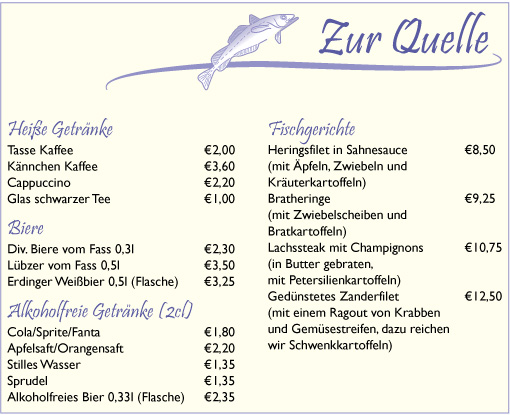
This is the menu of the restaurant Zur Quelle. It offers the following items:
Heiße Getränke: Tasse Kaffee €2,00 Kännchen Kaffee €3,60 Cappuccino €2,20 Glas schwarzer Tee €1,00
Biere: Div. Biere vom Fass 0,3l €2,30 Lübzer vom Fass 0,5l €3,50 Erdinger Weißbier 0,5l (Flasche) €3,25
Alkoholfreie Getränke (2cl): Cola/Sprite/Fanta €1,80 Apfelsaft/Orangensaft €2,20 Stilles Wasser €1,35 Sprudel €1,35 Alkoholfreies Bier 0,33l (Flasche) €2,35
Fischgerichte: Heringsfilet in Sahnesauce (mit Äpfeln, Zwiebeln und Kräuterkartoffeln) €8,50 Bratheringe (mit Zwiebelscheiben und Bratkartoffeln) €9,25 Lachssteak mit Champignons (in Butter gebraten, mit Petersilienkartoffeln) €10,75 Gedünstetes Zanderfilet (mit einem Ragout von Krabben und Gemüsestreifen, dazu reichen wir Schwenkkartoffeln) €12,50
Now listen to the audio clip below, and practise ordering a main course by following the whispered prompts you hear. You will start by calling (rufen) the waitress.
Beispiel
You hear: Rufen Sie die Kellnerin.
You say: Entschuldigung!
You hear: Entschuldigung!
Transcript: Audio 14
Bitte hören Sie und sprechen Sie.
(Rufen Sie die Kellnerin.)
6 Paying the bill
Activity 20
Listen to this customer paying his bill, then use the vocabulary below to write four German phrases corresponding to the English prompts. Each word should only be used once.
Transcript: Audio 15
Hören Sie bitte.
das • getrennt • ich • macht • möchte • oder • so • stimmt • zahlen • zusammen
- 1. I’d like to pay. (3 words)
- 2. Together or separately? (3 words)
- 3. That comes to … (2 words)
- 4. Keep the change. (2 words)
Answer
- Ich möchte zahlen.
- Zusammen oder getrennt?
- Das macht …
- Stimmt so. (literally ‘It’s correct like that.’)
- Vokabeln
- ich hatte I had
- kosten cost
Activity 21
Listen to this conversation between a diner and the waitress. Pay particular attention to the prices mentioned, then answer the questions below.
Transcript: Audio 16
Hören Sie bitte.
- 1. What is the price of the salmon steak?
Answer
€10.75
- 2. Which item costs €3.25?
Answer
the beer
- 3. How much is the herring?
Answer
€9.25
- 4. What does the corrected bill come to?
Answer
€12.50
- 5. How much does the diner give the waitress altogether?
Answer
€13.00
Now listen again, concentrating on the language used by the customer querying the bill. Practise using this language by reading aloud the customer’s part from the transcript as you play the clip.
Transcript: Audio 16
Hören Sie bitte.
Activity 22
Use some of the language you have been learning by taking part in a dialogue that might take place at the end of a meal with a colleague in a restaurant. You want to pay separately, and you round your own bill up to €20. Begin by calling the waiter and follow the other prompts in the recording. Again, you may want to use the transcript to guide you.
Transcript: Audio 17
Hören Sie und sprechen Sie.
(Rufen Sie den Kellner)
Activity 23
Now listen to some customers paying separately, and note down the price of each item listed below.
Transcript: Audio 19
Bitte hören Sie.
| Tee mit Zitrone |
To use this interactive functionality a free OU account is required. Sign in or register.
|
| Tasse Kaffee |
To use this interactive functionality a free OU account is required. Sign in or register.
|
| Kännchen Kaffee |
To use this interactive functionality a free OU account is required. Sign in or register.
|
| Kuchen |
To use this interactive functionality a free OU account is required. Sign in or register.
|
| Wasser |
To use this interactive functionality a free OU account is required. Sign in or register.
|
Answer
| Tee mit Zitrone | €2,20 |
| Tasse Kaffee | €2,50 |
| Kännchen Kaffee | €3,80 |
| Kuchen | €2,50 |
| Wasser | nichts |
Language: Numbers 1–100
You have heard some of the numbers from 1 to 100 in the recordings. Here are the numbers 1–10 in writing:
0 – null 1 – eins 2 – zwei 3 – drei | 4 – vier 5 – fünf 6 – sechs 7 – sieben | 8 – acht 9 – neun 10 – zehn |
The numbers from 11 to 20 are very similar to English:
11 – elf 12 – zwölf 13 – dreizehn 14 – vierzehn | 15 – fünfzehn 16 – sechzehn 17 – siebzehn 18 – achtzehn | 19 – neunzehn 20 – zwanzig |
From 20 onwards, numbers follow a regular pattern:
21 – einundzwanzig 22 – zweiundzwanzig 23 – dreiundzwanzig 24 – vierundzwanzig | 30 – dreißig 40 – vierzig 50 – fünfzig 60 – sechzig | 70 – siebzig 80 – achtzig 90 – neunzig 100 – hundert or einhundert |
Note how you say ‘one-and-twenty’ in German rather than ‘twenty-one’.
7 Snack foods
Culture: Imbissbuden
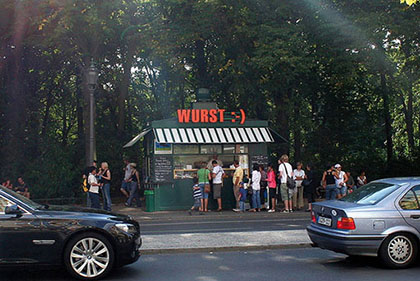
Photograph of a snack stand in a busy street. The sign on it says Wiener Würstl
You can buy different sausages, such as Bockwurst, Bratwurst and Currywurst, throughout the German-speaking countries in snack bars (Imbissbuden), and there are over 40 different regional varieties of Bockwurst alone. The sausages may be served in a bread roll (Brötchen), with potato salad (Kartoffelsalat), Sauerkraut or chips (Pommes frites or Fritten), and of course a little mustard (Senf).
Snack bars may be located in a mobile stand, a kiosk or a small shop, and many take the form of a Stehcafé or Stehimbiss, which provides no seating, just a few tall tables that customers can stand at while they eat their snacks. The Austrian Würstlstand pictured here is in Vienna (Wien).
- Vokabeln
- ihr zu Ehren in its honour
hat … erfunden invented
hat … angeboten offered
nicht nur not only
Activity 24
This is a text about two of the most popular snacks in Germany: the Currywurst and the Döner. You do not have to understand every word but try to get the gist of the two paragraphs. Then decide whether the six statements beneath are richtig (true) or falsch (false) according to the text.
Täglich lockt die Currywurst
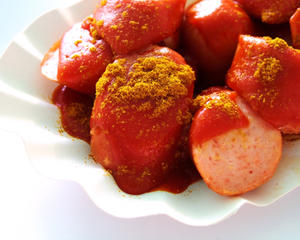
Picture of pieces of German sausage in curry sauce
Die Berliner Imbiss-Spezialität gibt es in vielen Variationen. In Berlin gibt es sogar ein Museum ihr zu Ehren: die „Currywurst“. Man sagt, Herta Heuwer hat die Currywurst am 4. September 1949 erfunden. An ihrem Imbissstand an der Ecke Kant-/Kaiser-Friedrich-Straße in Charlottenburg hat sie gebratene Brühwurst mit einer Soße aus Tomatenmark, Currypulver, Worcestershiresauce und weiteren Zutaten angeboten. Heute gibt es viele traditionelle Imbisse, wo man die Spezialität kaufen kann.
Döner + Falafel: Der Berliner Kultsnack
Was ist fast noch typischer für Berlin als die Currywurst? Der Döner! Der Döner ist das beliebteste Fast Food-Gericht in Deutschland, und wo kann man das besser essen als Berlin? Nicht nur in Kreuzberg findet man an jeder Ecke einen Imbiss mit Döner und Falafel. Einige haben Kultstatus wie das Habibi am Winterfeldtplatz.
a.
richtig
b.
falsch
The correct answer is b.
a.
richtig
b.
falsch
The correct answer is b.
a.
richtig
b.
falsch
The correct answer is a.
a.
richtig
b.
falsch
The correct answer is a.
a.
richtig
b.
falsch
The correct answer is a.
a.
richtig
b.
falsch
The correct answer is b.
Comment
Brühwurst is not a specific type of sausage, but a category of uncooked sausage, usually of finely minced pork or beef, which has undergone some kind of heat treatment during the manufacturing process. Further cooking is then necessary prior to serving. 60% of all sausages in Germany fall into this category.
- Vokabeln
- einmal once, one portion
- zweimal twice, two portions
- dreimal three times, three portions
- das Grillhähnchen grilled chicken
- Pommes frites (pl.) chips
- eine Portion Pommes one portion of chips (colloquial)
Activity 25
Now practise ordering some items at an Imbissstube. The items you want are indicated on the following price list. Ask for each item separately in response to the questions you hear in the recording.
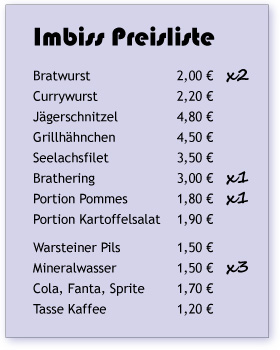
This is the price list of a snack bar which lists the following items and prices, and (for those being ordered) how many are required:
Imbiss Preisliste
Bratwurst 2,00 € (= 2)
Currywurst 2,20 €
Jägerschnitzel 4,80 €
Grillhähnchen 4,50 €
Seelachsfilet 3,50 €
Brathering 3,00 € (= 1)
Portion Pommes 1,80 € (= 1)
Portion Kartoffelsalat 1,90 €
Warsteiner Pils 1,50 €
Mineralwasser 1,50 € (= 3)
Cola, Fanta, Sprite 1,70 €
Tasse Kaffee 1,20 €
Transcript: Audio 29
Bitte hören Sie und sprechen Sie.
- Vokabeln
- beliebteste most popular
- bevorzugen prefer
Activity 26
Here is a chance to practise using some numbers. Read the following statistical information collected in a Süddeutsche Zeitung survey about people’s favourite snacks, and then answer the questions you hear in the recording. There is no need for complete sentences here; just answer in short phrases.
Was für Snacks essen die Deutschen gern?
Wenn der kleine Hunger kommt, ist die Pizza für viele der beliebteste Snack. 71 Prozent der Deutschen bevorzugen das italienische Gericht, wenn sie sich unterwegs etwas zu essen kaufen.
Auf Platz zwei ist mit 61 Prozent der Befragten ganz klassisch das belegte Brötchen.
59 Prozent der Deutschen kaufen am Imbissstand Grillhähnchen.
Auf Platz vier mit 54 Prozent kommt der Klassiker an der Imbissbude – die Bratwurst.
Vor allem die 14- bis 29-Jährigen essen besonders gern Hamburger mit Pommes. Wenn man aber das Ergebnis nach Frauen und Männern trennt, ist es ganz anders. Frauen essen mehr fleischlose Speisen, besonders Sushi. Und auch mal einen vegetarischen Burger.
(shortened and adapted from: http://www.sueddeutsche.de/ leben/ fastfood-die-beliebtesten-snacks-der-deutschen-1.534483)
Transcript: Audio 33
Bitte hören Sie und sprechen Sie.
Wie viel Prozent der Deutschen essen am liebsten Pizza?
➜
Einundsiebzig Prozent.
Welcher Snack kommt auf Platz zwei mit einundsechsig Prozent?
➜
Das belegte Brötchen.
Wie viel Prozent kaufen Grillhähnchen am Imbissstand?
➜
Neunundfünfzig Prozent.
Und wie viel Prozent bevorzugen die Bratwurst?
➜
Vierundfünfzig Prozent.
Welche Altersgruppe isst gern Hamburger mit Pommes?
➜
Die Vierzehn- bis Neunundzwanzigjährigen.
Und was essen die Frauen besonders gern?
➜
Sushi oder vielleicht einen vegetarischen Burger.
Activity 27
Look at the following image which demonstrates the various terms shown on a typical German wine label. Some of the vocabulary is quite specialised, but before reaching for your dictionary, see how many of them you can match to the English translations below.
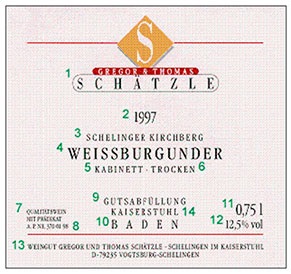
This image is an original wine label of a German wine. All items on the label are numbered. The items are the following:
1 Gregor & Thomas Schätzle
2 1997
3 Schelinger Kirchberg
4 Weissburgunder
5 Kabinett
6 Trocken
7 Qualitätswein mit Prädikat
8 AP NL 370 01 98
9 Gutsabfüllung
10 Baden
11 0,75l
12 12,5%
13 Weingut Gregor & Thomas Schätzle – Schelingen im Kaiserstuhl – D-79235 Vogtsburg – Schelingen
14 Kaiserstuhl
Producer
1 - Erzeuger
Year
2 - Jahrgang
Location
3 - Ort, Lage
Grape variety
4 - Rebsorte
Quality
5 - Qualitätsstufe
Flavour
6 - Geschmacksrichtung
Grade
7 - Prädikat
Official control number
8 - offizielle A.P.-Nummer
Bottler
9 - Abfüller
Wine-producing region (1 of 13)
10 - Weinbaugebiet (1 von 13)
Volume
11 - Füllvolumen
Alcohol content
12 - Alkoholgehalt
Producer's address
13 - Erzeugeradresse
Wine-producing area
14 - Weinbaubereich
Using the following two lists, match each numbered item with the correct letter.
Producer
Year
Location
Grape variety
Quality
Flavour
Grade
Official control number
Bottler
Wine-producing region (1 of 13)
Volume
Alcohol content
Producer's address
Wine-producing area
a.1 - Erzeuger
b.12 - Alkoholgehalt
c.8 - offizielle A.P.-Nummer
d.13 - Erzeugeradresse
e.10 - Weinbaugebiet (1 von 13)
f.14 - Weinbaubereich
g.7 - Prädikat
h.4 - Rebsorte
i.3 - Ort, Lage
j.6 - Geschmacksrichtung
k.5 - Qualitätsstufe
l.2 - Jahrgang
m.9 - Abfüller
n.11 - Füllvolumen
- 1 = a
- 2 = l
- 3 = i
- 4 = h
- 5 = k
- 6 = j
- 7 = g
- 8 = c
- 9 = m
- 10 = e
- 11 = n
- 12 = b
- 13 = d
- 14 = f
Answer
- Producer
- Year
- Location
- Grape variety
- Quality
- Flavour
- Quality
- Official control number
- Bottler
- Wine-producing region (1 of 13)
- Volume
- Alcohol content
- Producer's address
- Wine-producing area
Skills: Developing confidence in using numbers
Continue to review numbers until you feel confident to use and understand them. Whenever you see phone numbers, statistics, and so on, try to say the number to yourself in German. Write down some large numbers, record yourself saying them out loud, come back later to listen and write them down, then compare what you’ve written with the original list.
Comment
German bureaucracy requires many things to have an official number, and that includes bottles of wine. Therefore every German quality wine has a control number or A.P.Nr (Amtliche Prüfungsnummer) on the label. This shows that the wine has been officially tested against legal minimum standards. The various components of the number identify the testing station (die Prüfstelle), location (Ort) of the producer, the producer (der Erzeuger), the batch (die geprüfte Partie) and the year (das Jahr) when it was tested.
Source of information: http://weinverkostungen.de/ die-amtliche-prufungsnummer-bei-wein-a-p-nr (Accessed December 2019)
Skills: Making connections with German
The German and the English languages are very closely related. You will notice this in the large number of words that are either spelled the same, as in Computer, Radio, Taxi or Institution, or where words are very similar in spelling and pronunciation, as in Wein, Glas, Haus, Lampe, trinken.
However, there are also many other cultural parallels which can help you understand written German. Using the example of the wine label you will see that wine labels are very similar in German speaking countries and many other countries, with the items printed in identical positions etc. Such similarities also apply to many other contexts in everyday life. Just think of conventions for signs at train or bus stations, road signs, telephone books, emails etc.
So do trust your instincts and look for connections to support your understanding of the German language.
Conclusion
We hope you have enjoyed this course. Now that you know how to talk about what food you like and dislike, and you have learned how to order food and pay for it, you may wish to try this language out on your next visit to a German-speaking country!
If you enjoyed this OpenLearn course, you might be interested in the Open University course L193 Rundblick: beginners’ German.
Or, if you are interested in other language short courses, rather than studying languages for a degree, you may want to have a look at what else is on offer here.
Take the next step

If you enjoyed this course, why not explore the subject further with our paid-for short course, Beginners German 2: mit Vergnügen!?
Acknowledgements
This course was written by the L193 Rundblick: beginners’ German course team.
Some branded products may be illustrated for the language teaching and learning purposes of this course only. The Open University does not endorse or recommend any of these products of which many variations would be available. See terms and conditions.
Except for third party materials and otherwise stated (see terms and conditions ), this content is made available under a Creative Commons Attribution-NonCommercial-ShareAlike 4.0 Licence .
Course image: Sascha Kohlmann in Flickr made available under Creative Commons Attribution-NonCommercial-ShareAlike 2.0 Licence.
The material acknowledged below is Proprietary and used under licence (not subject to Creative Commons Licence). Grateful acknowledgement is made to the following sources for permission to reproduce material in this course:
© Elena Kouptsova-Vasic/dreamstime.com
All photos © The Open University except:
Figure 3 (composite, image 3): © Anpet2000(Andriy Petrenko) / Dreamstime
Figure 6: © Elizabeth Clifford
Figure 8: © Maren Oredein
Figure 9: Kind permission given to use from Hotel Sacher / Sacher.com
Figure 11: © Capitan Jen / Flickr
Figure 12: © visitBerlin / Philip Koschel
Figure 13: © visitBerlin / Philip Koschel
Figure 15: © Weingutschaetzle.de
Audio material produced by The Open University.
Video material produced for The Open University by Salon Deluxe, Graz, Austria.
Every effort has been made to contact copyright owners. If any have been inadvertently overlooked, the publishers will be pleased to make the necessary arrangements at the first opportunity.
Don't miss out:
If reading this text has inspired you to learn more, you may be interested in joining the millions of people who discover our free learning resources and qualifications by visiting The Open University - www.open.edu/ openlearn/ free-courses
Copyright © 2016 The Open University
